Catalogue Entry
Citation
Chicago:
Joseph Baillio, “Jean Marc Nattier, Portrait of Isidore Florimond Marié, Seigneur de Toulle et de Foucaucourt-hors-Nesle, a Knight of the Royal French Military Order of Saint-Louis, 1741,” catalogue entry in French Paintings and Pastels, 1600–1945: The Collections of the Nelson-Atkins Museum of Art, ed. Aimee Marcereau DeGalan (Kansas City: The Nelson-Atkins Museum of Art, 2024), https://doi.org/10.37764/78973.5.324.5407.
MLA:
Baillio, Joseph. “Jean Marc Nattier, Portrait of Isidore Florimond Marié, Seigneur de Toulle et de Foucaucourt-hors-Nesle, a Knight of the Royal French Military Order of Saint-Louis, 1741,” catalogue entry. French Paintings and Pastels and Pastels, 1600–1945: The Collections of The Nelson-Atkins Museum of Art, edited by Aimee Marcereau DeGalan, Nelson-Atkins Museum of Art, 2024. doi: 10.37764/78973.5.324.5407.
The sons of Marc Nattier (1642–1705)—a relatively minor portraitist during the second half of the reign of Louis XIV—and the miniaturist Marie Courtois (ca. 1655–1703), Jean Marc Nattier and his older brother, Jean-Baptiste (1678–1726), learned the practical aspects of painting, drawing, and composition in their father’s studio. For a time they attended the drawing and theoretical classes of the Académie Royale de peinture et de sculpture (Royal Academy of Painting and Sculpture), of which Marc Nattier was a member in good standing. The two siblings were awarded a yearly stipend from the royal arts administration and were prizewinners in the Académie’s student competitions. Their painting styles were remarkably similar, with Jean-Baptiste styling himself Nattier l’aîné (the oldest) and Jean Marc signing his works Nattier le jeune (the young). In 1709, with the support of the Academician Jean Jouvenet (1644–1717), the younger Nattier was offered a scholarship to study in Rome, but he declined the honor in order to further a lucrative career as a portraitist. In 1715, Jean Marc sought entry into the Académie as a history painter, but he only completed his diploma piece—Perseus Petrifying Phineus with the Head of the Gorgon (Musée des Beaux-Arts, Tours)—three years later.
Jean Marc was summoned to Holland in 1717 on orders from the Russian Tsar Peter I (Peter the Great), who was by then in the second phase of his “Grand Embassy,” a learning and diplomatic tour of socially, culturally, and scientifically advanced Western European countries. During the time he resided in Amsterdam and the Hague, Nattier painted a three-quarter-length portrait of the Tsarina Catherine I (1717; The State Hermitage, Saint Petersburg) and produced a generic battle piece intended to commemorate Russia’s 1709 victory over the Swedish troops at Poltava in the Ukraine (Battle at Lesnaya, 1717; Pushkin Museum, Moscow). When the young French artist returned to Paris, he painted from life a likeness of the Tsar wearing a suit of plate armor (Fig. 1), which was the first of many military portraits of men wearing medieval-like suits of armor, with battle scenes raging in the background to set off their martial attire.1Peter had chosen to be depicted in a complete suit of armor by Godfrey Kneller in London in 1698 for his host King William III (The Royal Collection Trust, The Queen’s Gallery, Buckingham Palace, inv. no. RCIN 405645, https://www.rct.uk/collection/405645/peter-the-great-tsar-of-russia-1672-1725. They were meant to remind the viewer that male sovereigns, princes, and courtiers upheld the ancient traditions of Europe’s warrior class.
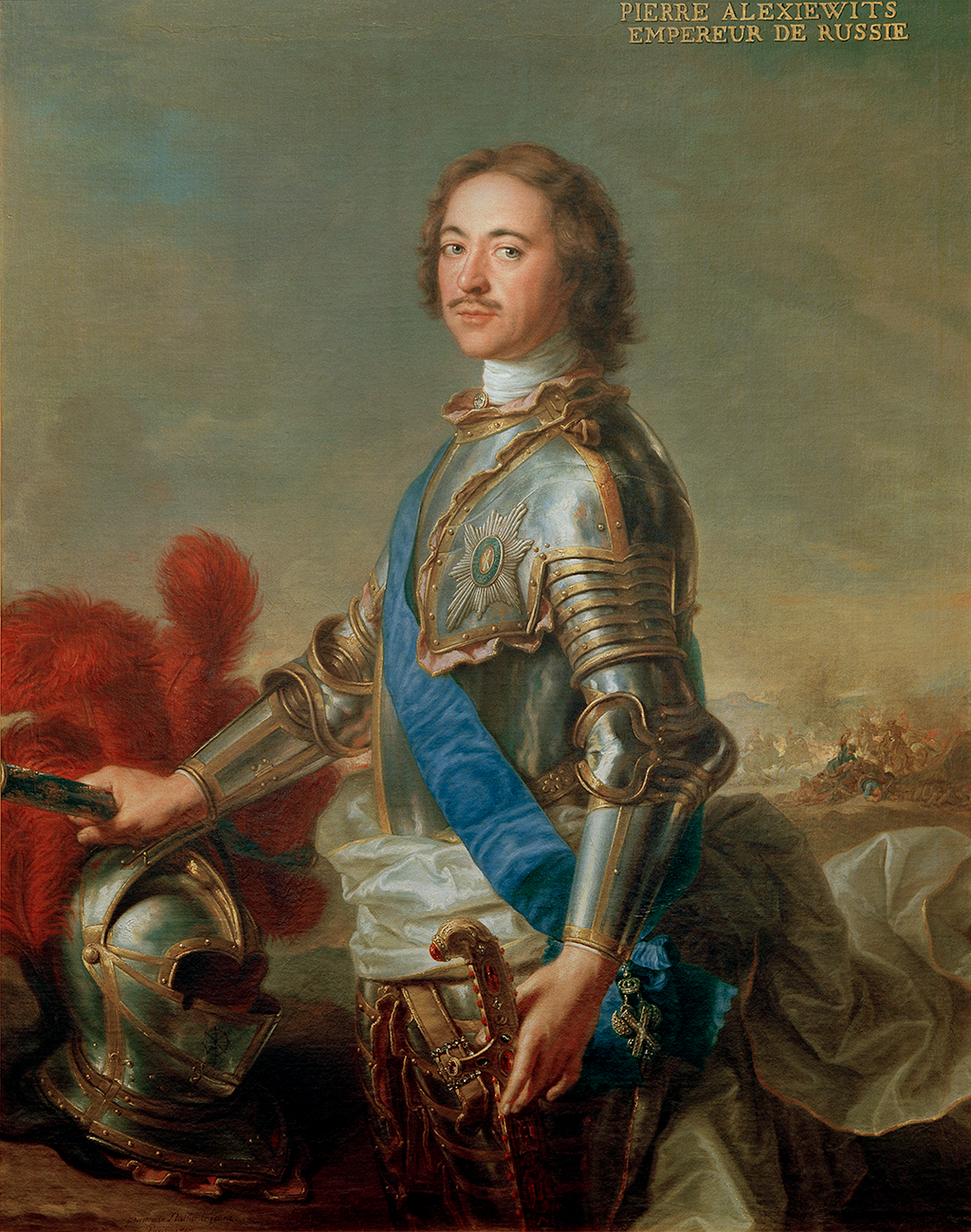
In 1719, the Nattier brothers were financially ruined in John Law’s Mississippi Bubble scheme.3The Mississippi Bubble “was a financial scheme in eighteenth-century France that triggered a speculative frenzy and ended in financial collapse.” See “Mississippi Bubble,” Encyclopedia Britannica, online edition, last edited October 18, 2002, https://www.britannica.com/event/Mississippi-Bubble. By August 1717, Antoine Crozat’s largely economic hold on Louisiana had been transferred to another monopoly, the Compagnie d’Occident or Compagnie du Mississippi, a scheme hatched by the Scottish economist John Law, who sold the idea to the Régent, Philippe, duc d’Orléans. To capitalize his plan for encouraging trade between France and its overseas colonies in the lower part of North America, Law created a royal bank and issued paper money backed by neither coinage nor bullion. As an enticement to attract gullible investors, he advertised Louisiana as an El Dorado where fortunes could be easily realized. The result was rampant speculation, and people like the Nattier brothers clamored to buy bonds and concessions of plantation land in the faraway colony. In the end, Law’s System collapsed in the so-called “Mississippi Bubble,” and many of those who had invested in it were left with worthless bonds, debt papers, and currency, or landed estates they were incapable of managing from afar. Jean Marc’s career, however, soon recovered. In 1721, he was hired to make drawings after paintings in the collection of the Regent, Philippe d’Orléans, the series of which was called the Recueil Crozat. He then associated himself with Jean-Baptiste Massé (1687–1767) on a vast engraving project recording Charles Le Brun’s ceiling decorations for the Palace of Versailles, specifically the Galerie des Glaces and the Salons de la Paix et de la Guerre. On the Feast of Corpus Christi in 1725, Nattier sent to the Exposition de la Jeunesse, near the Pont-Neuf in Paris, his full-length swagger portrait of Count Moritz Hermann of Saxony (Fig. 2), the son of Augustus the Strong, Elector of Saxony, and his Swedish mistress, Countess Aurora Von Königsmark. In it, the count is dressed in a suit of armor decorated with the insignia of the Polish Order of the White Eagle and is leaning on a sheathed saber.
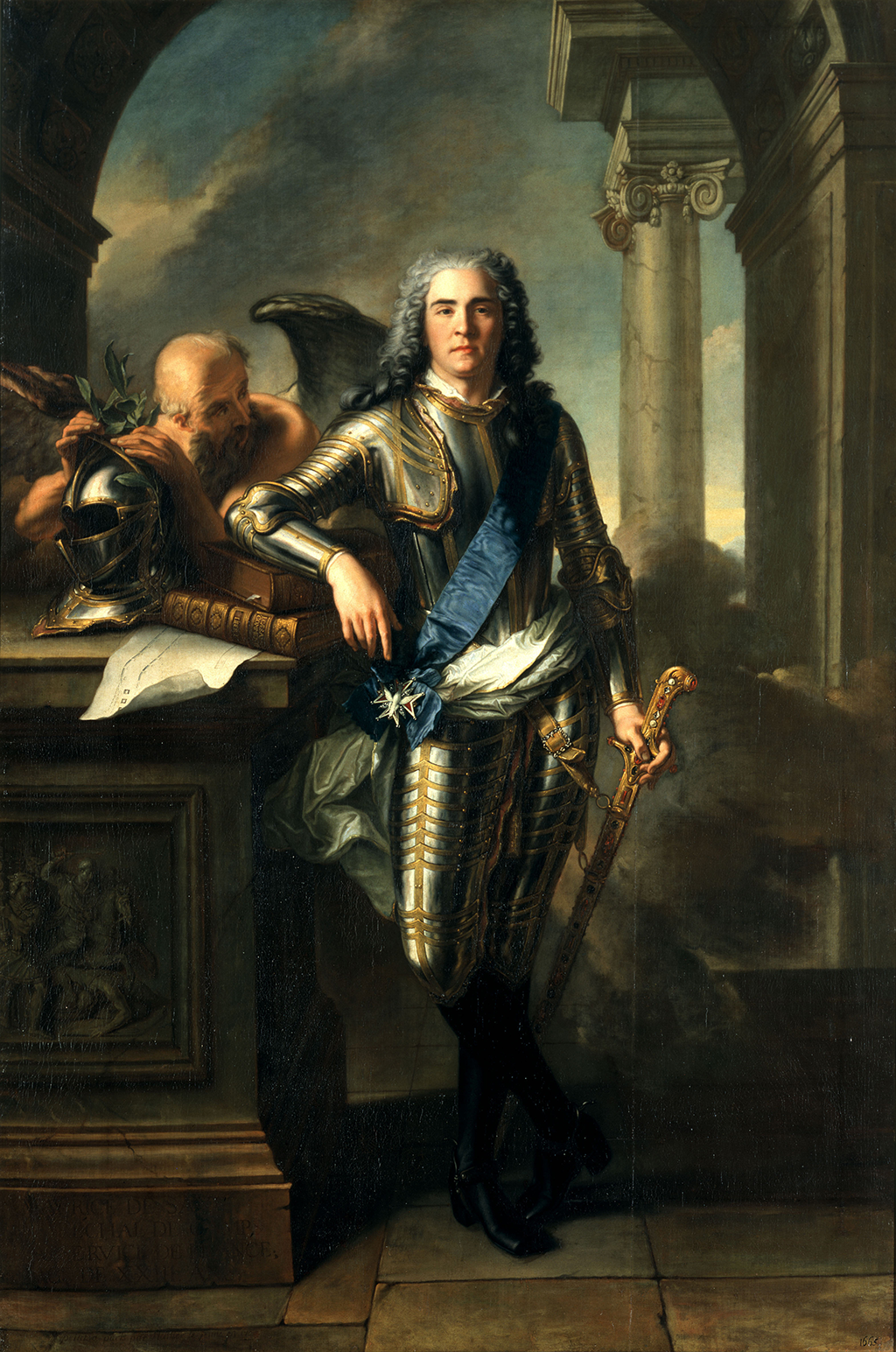
From the mid-1730s through the mid-1740s, Nattier became a regular at
the SalonSalon, the: Exhibitions organized by the French Royal Academy of Painting and Sculpture (Académie Royale de Peinture et de Sculpture) and its successor the Academy of Fine Arts (Académie des Beaux Arts), which took place in Paris from 1667 onward. and earned the title of painter-in-ordinary to the king,
completing portraits of the queen and her children, including the
dauphin, as well as the king’s favorite mistress, the future Marquise de
Pompadour. In 1741, Nattier painted the Nelson-Atkins portrait of a
knight of the Order of Saint-Louis, a military distinction founded in
1693 by Louis XIV to distinguish valiant and meritorious commissioned
officers in the royal armed services without regard to their birth and
social rank.5For a detailed history of the Order of Saint-Louis, now extinct, as well as a listing of the promotions that took place during the War of the Austrian Succession, see Alexandre Mazas and Théodore Anne, Histoire de l’ordre royal et militaire de Saint-Louis, depuis son institution en 1693 jusqu’en 1830, 2nd ed. (Paris: Firmin-Didot frères, fils, 1861), especially 1:311–35. At the beginning of the second volume is a recapitulation of the names of officers not cited in the first, and in the third volume is an “Alphabetical table of the names of dignitaries and knights of the royal and military order of Saint-Louis cited in this work,” 3:555–608, and a list of the knights of the order whose names were discovered after the original list was published, 609–23.
The painting has sometimes been misdated to the year 1744 or even 1747, due perhaps to the illegible last digit near the artist’s signature at lower left. However, with the aid of recent photomicroscopy undertaken by Sophia Boosalis, Kress Conservation Fellow, Nelson-Atkins Museum, the date is clearly “1741.” (The painting has sometimes been misdated in the
literature to the year 1744 or even 1747, due perhaps to the illegible last digit
near the artist’s signature at lower left.) The subject is obviously a
relatively high-ranking troop commander in the royal infantry or the
cavalry of Louis XV, then in the twenty-sixth year of his reign. The
handsome monarch was at the time still very popular and was called “le
Bien Aimé” (the Well Beloved); Nattier also painted a nearly
half-length portrait of him in armor draped in an ermine-lined blue cloak sewn with gold fleurs-de-lis (Fig. 3).6The portrait is best known from a version Nattier created with studio assistance, which is today in the State Hermitage Museum, St. Petersburg, inv. no. ГЭ-1123, https://www.hermitagemuseum.org/wps/portal/hermitage/digital-collection/01.+paintings/37412. Another version was last recorded with Perrin Antiquaires, Paris (at TEFAF, Maastricht, June 2022; see Fig. 3). Neither version is signed nor dated.
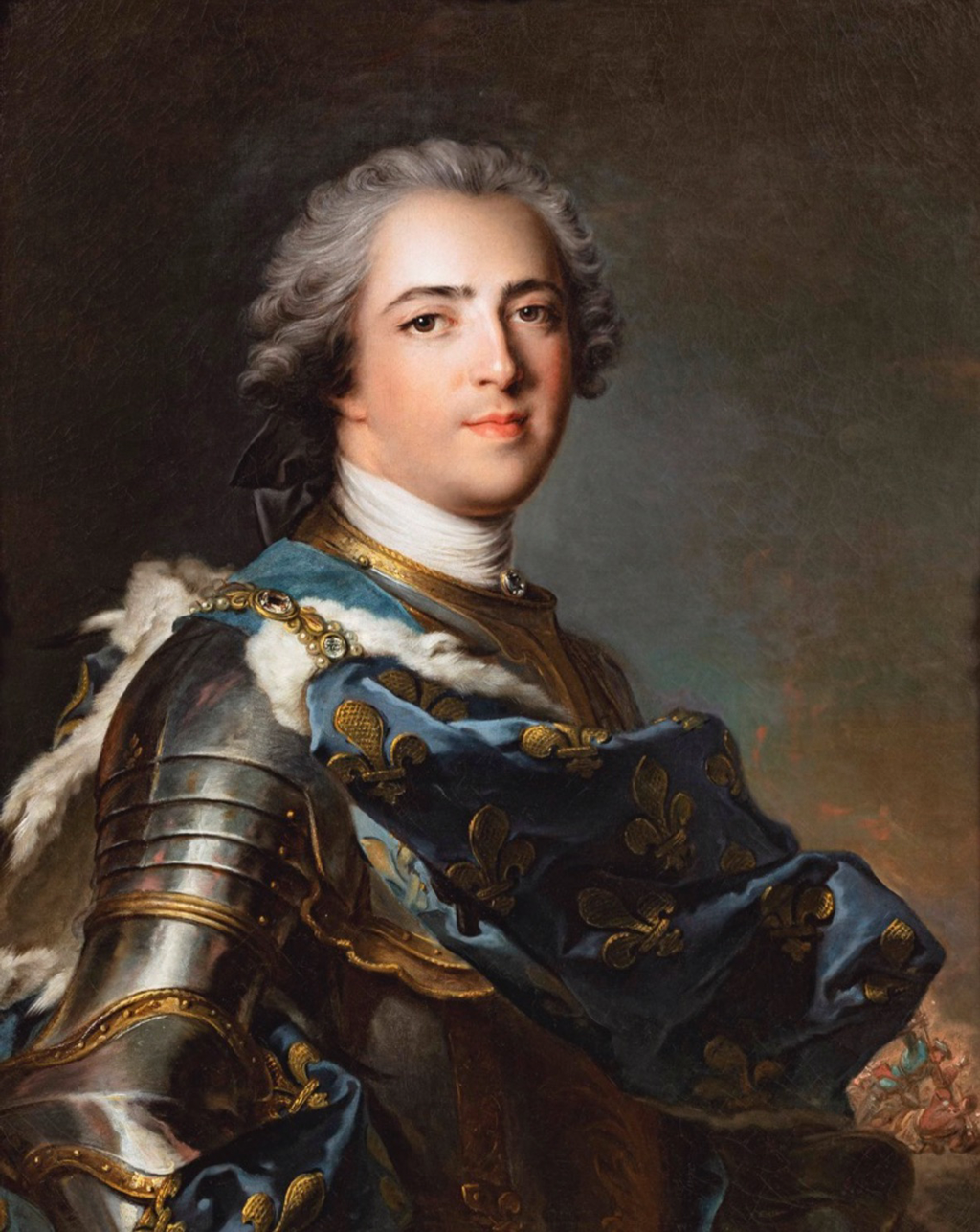
These were the specific circumstances in which this dashing, nearly half-length portrait of a commissioned officer of the French royal infantry was painted. Dressed in a fawn-colored coat with large turned-back red cuffs held in place by silver buttons, he stands in front of a field on which a battle is raging, against a patch of cloud-streaked sky. Over his uniform, the rather strongly built man—whose receding hairline suggests that he is in his thirties or early forties—wears a cuirasscuirass: The breastplate and back plate of armor, which are fastened together., a pair of pauldronspauldrons: Plate armor that covers one’s shoulders. at the shoulders, and fauldsfaulds: Plate armor worn below a breastplate to protect the waist and hips. to protect his hips. Across the subject’s chest is a white silk sash tied in a large bow under his left arm. Peeking out from under the shoulder plate on his left side are the scarlet ribbon and gold-and-enamel star of the royal military order of Saint-Louis, of which he is obviously a knight.
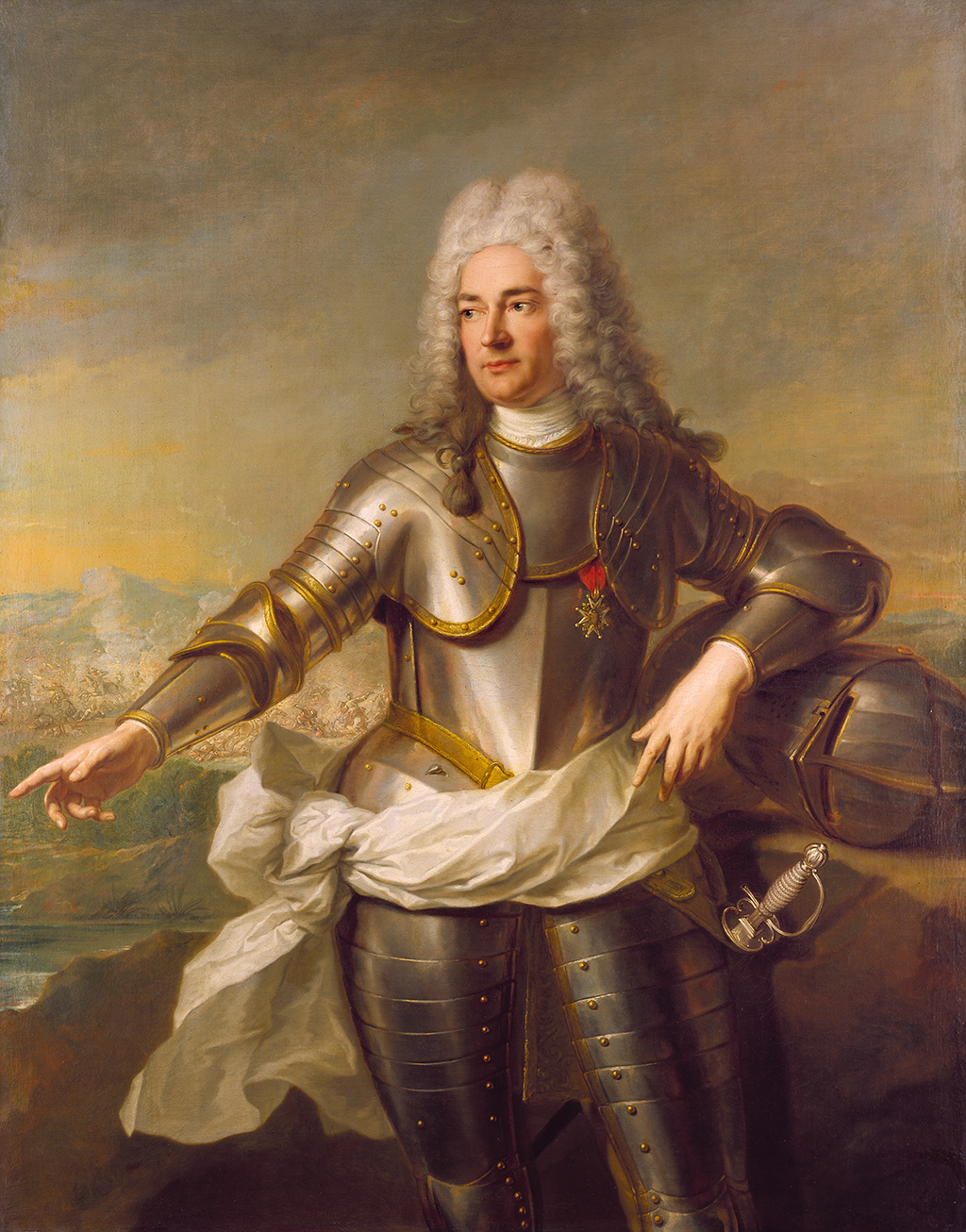
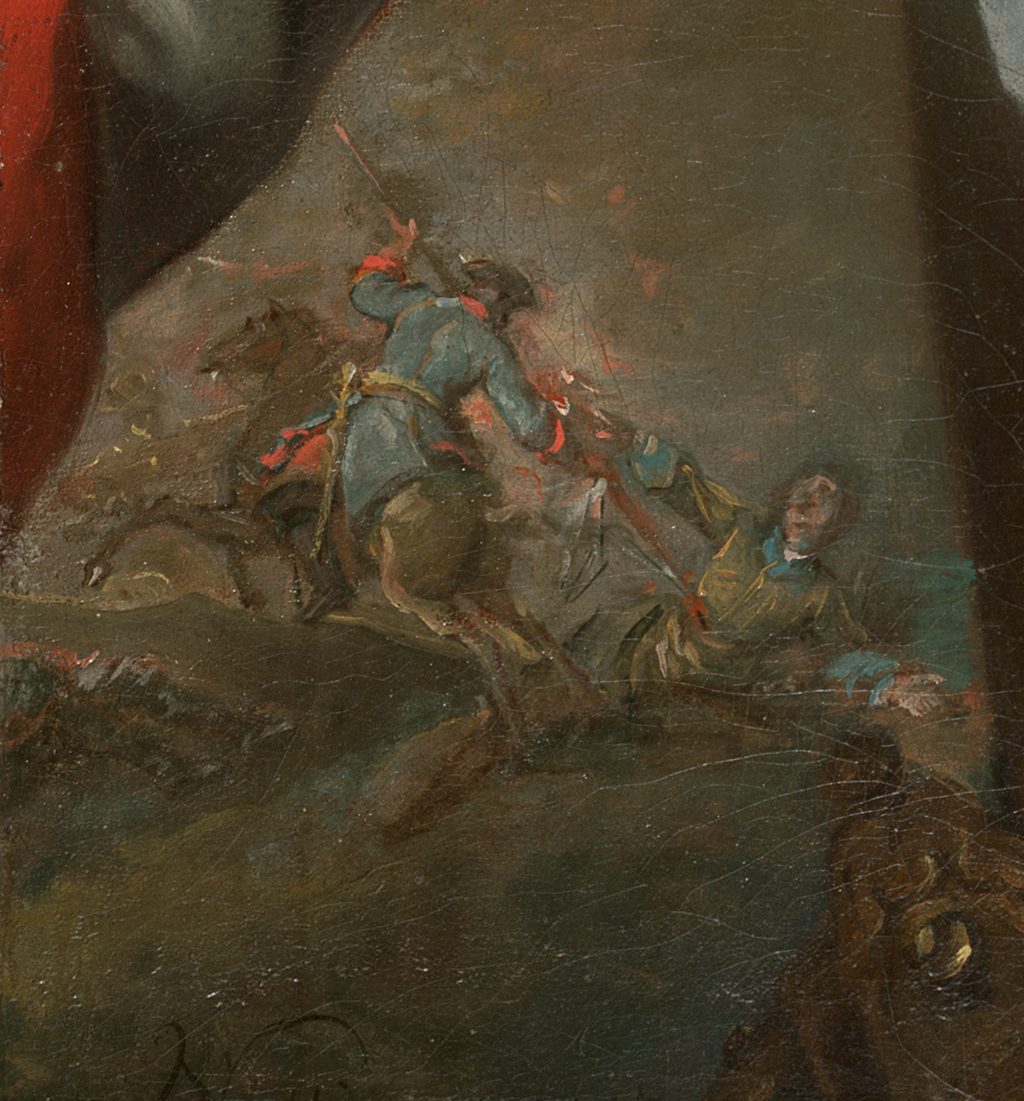 Fig. 5. Detail of Portrait of Isidore Florimond Marié, Seigneur de Toulle et de Foucaucourt-hors-Nesle (Fig. 1), showing an infantryman being speared by a cavalryman
Fig. 5. Detail of Portrait of Isidore Florimond Marié, Seigneur de Toulle et de Foucaucourt-hors-Nesle (Fig. 1), showing an infantryman being speared by a cavalryman
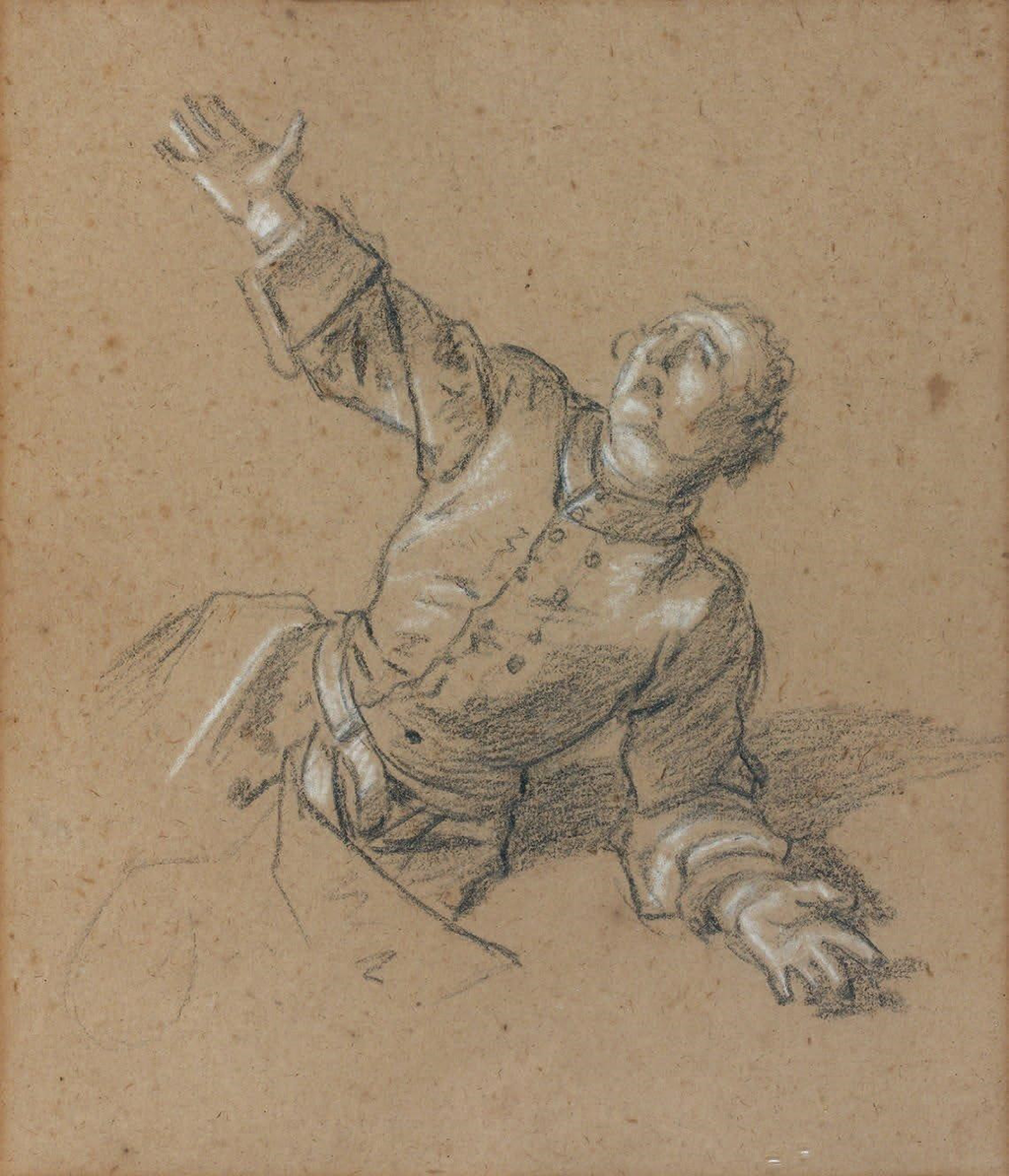 Fig. 6. Jean Marc Nattier, Study of a Soldier on the Ground with Arms Outstretched, ca. 1740–44, black and white chalk on tan paper, 9 7/16 x 8 in. (24 x 20.4 cm), presently available through Stéphane Renard Fine Art, Paris. Photo: © Stéphane Renard Fine Art
Fig. 6. Jean Marc Nattier, Study of a Soldier on the Ground with Arms Outstretched, ca. 1740–44, black and white chalk on tan paper, 9 7/16 x 8 in. (24 x 20.4 cm), presently available through Stéphane Renard Fine Art, Paris. Photo: © Stéphane Renard Fine Art
The Château de Senarpont, part of a fiefdom that belonged in the mid-eighteenth century to the De Monchy and Nassau-Sieghen families, was acquired in 1785 from Prince Charles Othon de Nassau-Seighen, who had previously destroyed a wing of it with cannon fire in a misguided attempt to show his guests what a military siege was like. The purchaser was Alexandre Marie Léon, comte Dary d’Ernemont, a Lieutenant Colonel in the Régiment de Foix and a knight of the military order of Saint-Louis. See Alcius Ledieu, “La Vallée de Liger et ses environs,” Mémoires de la Société d’émulation d’Abbeville, ser. 3 (Abbeville: C. Paillart, 1887), 4:356–57. The last
male scion of the Darys was Adolphe-Léon, comte Dary, marquis de
Senarpont (1806–90), who left the painting to his widow, the dowager Marie Léonie Dary,
marquise de Senarpont (1836–1912). The auction of many of the contents of the
Château de Foucaucourt-hors-Nesle, where the painting likely remained since its creation,
were sold four months after the marquise’s
demise on January 10, 1912. The Nelson-Atkins Nattier may have been
featured in that sale, the catalogue for which included a painting
described simply as “Un Portrait d’homme, par Nattier” and dated
(misdated, if it is the Nelson-Atkins painting) to the year 1747.
The current Senarpont heir, Charles de Broissard, posited that Nattier’s sitter should be identified as Isidore Florimond Marié, seigneur de Toulle et de Foucaucourt-hors-Nesle (1705–92).10Charles de Boissard to Joseph Baillio, January 10, 21, and 22, 2019. During the War of the Austrian Succession, Marié de Toulle served as a captain in the unit of the Grammont Cavalerie,11The Burgundian nobleman Pierre de Grammont Fallon, called the “marquis de Grammont” (1708–95), was in charge of the cavalry unit to which Isidore Florimond Marié de Toulle belonged during the first half of the 1740s, notably during the campaigns fought by the French in Bavaria, Bohemia, and along the Rhine under various marshals. The sitter’s name appears in the list of members of the Académie d’Amiens, in [Jacques Hébrail and Joseph de La Porte], La France Littéraire (Paris: Chez la Venve Duchesne, 1769), 1:47: “MARIÉ DE TOULLE, Chevalier de l’Ordre Royale [sic] et Militaire de Saint-Louis.” For a description of the uniform of the Grammont Cavalerie, see [Charles Louis d’Authville des Amourettes], Essai sur la Cavalerie, tant ancienne que moderne (Paris: Chez Charles-Antoine Jombert, 1756), 161. It would make sense if Nattier’s portrait was intended to commemorate’s the sitter’s induction into the Order of Saint-Louis. the uniform of which matches the regimentals worn by the subject of the portrait. In his retirement, he served as Inspector-General of the Royal Stables in the region of the Soissonais and was a member of the Académie des Arts, Sciences, et Belles-Lettres of the city of Amiens.12François-Irénée Darsy, Les doléances du peuple et les victimes: Souvenirs de la Révolution en Picardie (Amiens: Imprimerie A. Douillet et Cie, 1887), 56. He authored an unpublished memoir that was once part of the archives of the Académie d’Amiens.13“Mémoires pour servir à l’histoire de la Campagne de Bohême, en 1741 et 1742.” See Jacques Lelong, Bibliothèque historique de la France, ed. Charles Marie Fevret de Fontette, rev. ed. (Paris: Jean-Thomas Herissant, 1769), 2:617, no. 24631. The text mistakenly identifies the name of the manuscript’s author as “M. de Soulle [sic] de l’Académie d’Amiens” and adds: “M. de Soulle [sic], Chevalier de S. Louis, a fait cette Campagne, étant alors Capitaine Commandant au Régiment, Cavalerie” (M. de Soulle [sic], Knight of Saint Louis, made this campaign, being then Commanding Captain of the Regiment, Cavalry). Marié de Toulle was married to Marie Thérèse Gresset (ca. 1718–78), the sister of the famous poet, dramatist, theologian, and member of the Académie Française, Jean-Baptiste Louis Gresset (1704–77), both of whom were natives of Amiens.14Gresset’s literary masterpiece was his humorous poem Vert-Vert ou les voyages du perroquet de la Visitation de Nevers (1734). Gresset’s shoulder-length, oval portrait had been painted in 1741 by Jean Marc Nattier, a rather poorly preserved work today in the Musée de Picardie in Amiens,15Inv. no. M.P. 1875-28. See Pierre de Nolhac, Nattier: Peintre de la cour de Louis XV (Paris: H. Floury, 1925), 50–51, 92–93, and 255. which was ultimately engraved by Augustin de Saint-Aubin. Perhaps on the advice of his brother-in-law, Marié de Toulle may have commissioned Nattier that same year to commemorate his successes on the battlefield.
Notes
-
Peter had chosen to be depicted in a complete suit of armor by Godfrey Kneller in London in 1698 for his host King William III (The Royal Collection Trust, The Queen’s Gallery, Buckingham Palace, inv. no. RCIN 405645, https://www.rct.uk/collection/405645/peter-the-great-tsar-of-russia-1672-1725.
-
See for example, Presumed Portrait of Comte Robert Jean Antoine François Franquetot de Coigny, 1699, Musée des Beaux-Arts, Caen, https://mba.caen.fr/oeuvre/portrait-presume-du-comte-de-coigny-gouverneur-de-caen.
-
The Mississippi Bubble “was a financial scheme in eighteenth-century France that triggered a speculative frenzy and ended in financial collapse.” See “Mississippi Bubble,” Encyclopedia Britannica, online edition, last edited October 18, 2002, https://www.britannica.com/event/Mississippi-Bubble. By August 1717, Antoine Crozat’s largely economic hold on Louisiana had been transferred to another monopoly, the Compagnie d’Occident or Compagnie du Mississippi, a scheme hatched by the Scottish economist John Law, who sold the idea to the Régent, Philippe, duc d’Orléans. To capitalize his plan for encouraging trade between France and its overseas colonies in the lower part of North America, Law created a royal bank and issued paper money backed by neither coinage nor bullion. As an enticement to attract gullible investors, he advertised Louisiana as an El Dorado where fortunes could be easily realized. The result was rampant speculation, and people like the Nattier brothers clamored to buy bonds and concessions of plantation land in the faraway colony. In the end, Law’s System collapsed in the so-called “Mississippi Bubble,” and many of those who had invested in it were left with worthless bonds, debt papers, and currency, or landed estates they were incapable of managing from afar.
-
“. . . ajoutent un caractère imperceptible de beauté” (add an aura of imperceptible beauty to a perfect likeness). Giovanni Giacomo Casanova de Seingalt, Mémoires (Paris: Bibliothèque de la Pléiade, 1959), 2:489–90.
-
For a detailed history of the Order of Saint-Louis, now extinct, as well as a listing of the promotions that took place during the War of the Austrian Succession, see Alexandre Mazas and Théodore Anne, Histoire de l’ordre royal et militaire de Saint-Louis, depuis son institution en 1693 jusqu’en 1830, 2nd ed. (Paris: Firmin-Didot frères, fils, 1861), especially 1:311–35. At the beginning of the second volume is a recapitulation of the names of officers not cited in the first, and in the third volume is an “Alphabetical table of the names of dignitaries and knights of the royal and military order of Saint-Louis cited in this work,” 3:555–608, and a list of the knights of the order whose names were discovered after the original list was published, 609–23.
The painting has sometimes been misdated to the year 1744 or even 1747, due perhaps to the illegible last digit near the artist’s signature at lower left. However, with the aid of recent photomicroscopy undertaken by Sophia Boosalis, Kress Conservation Fellow, Nelson-Atkins Museum, the date is clearly “1741.”
-
The portrait is best known from a version Nattier created with studio assistance, which is today in the State Hermitage Museum, St. Petersburg, inv. no. ГЭ-1123, https://www.hermitagemuseum.org/wps/portal/hermitage/digital-collection/01.+paintings/37412. Another version was last recorded with Perrin Antiquaires, Paris (at TEFAF, Maastricht, June 2022; see Fig. 3). Neither version is signed nor dated.
-
The war, which was also fought in North America, the West Indies, and the Indian subcontinent, continued until a general cessation of hostilities in 1748 and the signing of the Treaty of Aix-la-Chapelle. France’s intervention was ultimately for nought, since Maria Theresa retained control of most of her father’s empire. The treaty, which many French people regarded as ignominious and favorable only to King Frederick of Prussia, made Louis XV lose much of his popularity among his own people.
-
Sold at auction in Paris, Millon et Associés, Hôtel Drouot, April 12, 2013, lot 159. Presently available through Stéphane Renard Fine Art, Paris, https://www.stephanerenard-fineart.com/artworks/categories/10/19-jean-marc-nattier-soldier-begging-for-mercy-study-for-the-victory-1717/.
-
A letter from the dealer Germain Seligmann to Ross E. Taggart, Senior Curator at NAMA, includes a passage about the work’s proposed De Senarpont history: “We did find, but how tenuous, a link that there had been a portrait of an officer by Nattier in the Château de Foucancourt-hors-Nesle [sic], which was included in an otherwise unimportant auction at the beginning of the century. Upon which, some time ago, I had the visit in New York of a Frenchman who, being a descendant of that Senarpont family, was not averse to believing that this brilliant officer could have been one of his ancestors.” Germain Seligmann to Ross E. Taggart, May 11, 1976, NAMA curatorial files.
The Château de Senarpont, part of a fiefdom that belonged in the mid-eighteenth century to the De Monchy and Nassau-Sieghen families, was acquired in 1785 from Prince Charles Othon de Nassau-Seighen, who had previously destroyed a wing of it with cannon fire in a misguided attempt to show his guests what a military siege was like. The purchaser was Alexandre Marie Léon, comte Dary d’Ernemont, a Lieutenant Colonel in the Régiment de Foix and a knight of the military order of Saint-Louis. See Alcius Ledieu, “La Vallée de Liger et ses environs,” Mémoires de la Société d’émulation d’Abbeville, ser. 3 (Abbeville: C. Paillart, 1887), 4:356–57.
-
Charles de Boissard to Joseph Baillio, January 10, 21, and 22, 2019.
-
The Burgundian nobleman Pierre de Grammont Fallon, called the “marquis de Grammont” (1708–95), was in charge of the cavalry unit to which Isidore Florimond Marié de Toulle belonged during the first half of the 1740s, notably during the campaigns fought by the French in Bavaria, Bohemia, and along the Rhine under various marshals. The sitter’s name appears in the list of members of the Académie d’Amiens, in [Jacques Hébrail and Joseph de La Porte], La France Littéraire (Paris: Chez la Venve Duchesne, 1769), 1:47: “MARIÉ DE TOULLE, Chevalier de l’Ordre Royale [sic] et Militaire de Saint-Louis.” For a description of the uniform of the Grammont Cavalerie, see [Charles Louis d’Authville des Amourettes], Essai sur la Cavalerie, tant ancienne que moderne (Paris: Chez Charles-Antoine Jombert, 1756), 161. It would make sense if Nattier’s portrait was intended to commemorate’s the sitter’s induction into the Order of Saint-Louis.
-
François-Irénée Darsy, Les doléances du peuple et les victimes: Souvenirs de la Révolution en Picardie (Amiens: Imprimerie A. Douillet et Cie, 1887), 56.
-
“Mémoires pour servir à l’histoire de la Campagne de Bohême, en 1741 et 1742.” See Jacques Lelong, Bibliothèque historique de la France, ed. Charles Marie Fevret de Fontette, rev. ed. (Paris: Jean-Thomas Herissant, 1769), 2:617, no. 24631. The text mistakenly identifies the name of the manuscript’s author as “M. de Soulle [sic] de l’Académie d’Amiens” and adds: “M. de Soulle [sic], Chevalier de S. Louis, a fait cette Campagne, étant alors Capitaine Commandant au Régiment, Cavalerie” (M. de Soulle [sic], Knight of Saint Louis, made this campaign, being then Commanding Captain of the Regiment, Cavalry).
-
Gresset’s literary masterpiece was his humorous poem Vert-Vert ou les voyages du perroquet de la Visitation de Nevers (1734).
-
Inv. no. M.P. 1875-28. See Pierre de Nolhac, Nattier: Peintre de la cour de Louis XV (Paris: H. Floury, 1925), 50–51, 92–93, and 255.
Technical Entry
Technical entry forthcoming.
Documentation
Citation
Chicago:
Glynnis Napier Stevenson, “Jean Marc Nattier, Portrait of Isidore Florimond Marié, Seigneur de Toulle et de Foucaucourt-hors-Nesle, a Knight of the Royal French Military Order of Saint-Louis, 1741,” documentation in French Paintings and Pastels, 1600–1945: The Collections of the Nelson-Atkins Museum of Art, ed. Aimee Marcereau DeGalan (Kansas City: The Nelson-Atkins Museum of Art, 2024), https://doi.org/10.37764/78973.5.324.4033.
MLA:
Stevenson, Glynnis Napier. “Jean Marc Nattier, Portrait of Isidore Florimond Marié, Seigneur de Toulle et de Foucaucourt-hors-Nesle, a Knight of the Royal French Military Order of Saint-Louis, 1741,” documentation. French Paintings and Pastels, 1600–1945: The Collections of The Nelson-Atkins Museum of Art, edited by Aimee Marcereau DeGalan, Nelson-Atkins Museum of Art, 2024. doi: 10.37764/78973.5.324.4033.
Provenance
Citation
Chicago:
Glynnis Napier Stevenson, “Jean Marc Nattier, Portrait of Isidore Florimond Marié, Seigneur de Toulle et de Foucaucourt-hors-Nesle, a Knight of the Royal French Military Order of Saint-Louis, 1741,” documentation in French Paintings and Pastels, 1600–1945: The Collections of the Nelson-Atkins Museum of Art, ed. Aimee Marcereau DeGalan (Kansas City: The Nelson-Atkins Museum of Art, 2024), https://doi.org/10.37764/78973.5.324.4033.
MLA:
Stevenson, Glynnis Napier. “Jean Marc Nattier, Portrait of Isidore Florimond Marié, Seigneur de Toulle et de Foucaucourt-hors-Nesle, a Knight of the Royal French Military Order of Saint-Louis, 1741,” documentation. French Paintings and Pastels, 1600–1945: The Collections of The Nelson-Atkins Museum of Art, edited by Aimee Marcereau DeGalan, Nelson-Atkins Museum of Art, 2024. doi: 10.37764/78973.5.324.4033.
Probably commissioned by the sitter, Isidore Florimond Marié de Toulle (1705–92), seigneur de Toulle and seigneur de Foucaucourt-hors-Nesle, chevalier de Saint-Louis, Amiens and Foucaucourt-Hors-Nesle, France, 1741–January 19, 1792 [1];
Probably by decent to his son, Louis Jean-Baptiste Marie Marié de Toulle (1759–1808), Amiens and Foucaucourt-Hors-Nesle, France, 1792–October 4, 1808;
Probably inherited by his wife, Marie Marguerite Françoise de Toulle (née François, 1769–1840), Foucaucourt-Hors-Nesle, France, 1808–January 14, 1840;
Probably by descent to her daughter Marie-Agathe Marié (née de Toulle, 1794–1875), Comtesse Dary de Senarpont, Foucaucourt-Hors-Nesle, France, 1840–February 25, 1875 [2];
Probably to her brother-in-law, Adolphe Léon Dary (1806–90), Comte Dary and Marquis de Senarpont, Château de Senarpont, Château de Foucaucourt-hors-Nesle, Amiens, France, and Paris, 1875–July 9, 1890 [3];
Inherited by his widow, Marie Léonie Dary (née de Chevigné, 1836–1912), Comtesse Dary and Marquise de Senarpont, Château de Senarpont, Château de Foucaucourt-hors-Nesle, France, and Paris, 1890–January 10, 1912 [4];
Purchased from her posthumous sale, Vente après Décès D’un très Bon Mobilier Ancien et Moderne, Dépendant de la Succession de Madame la Marquise de Senarpont et garnissant Le Château de Foucaucourt-hors-Nesle, Commune de Foucaucourt-hors, Nesle, Somme, Château de Foucaucourt-hors-Nesle, France, May 21, 1912, unnumbered, as Un Portrait d’Homme, and dated 1747, to Hecquet, Amiens, 1912 [5];
Louis Gabriel Albert (1885–1972) and Antoinette Céleste (née Lasson, 1890–1962) Watel-Dehaynin, Paris, by March 19, 1962–July 23, 1972 [6];
Purchased at his posthumous sale, Tableaux anciens, dessins, pastels et tableaux par ou attribués à L.-L. Boilly, G.-M. Crespi, J.-H. Fragonard, J.-B. Greuze, J.-B. Huet, Sir Th. Lawrence, M.-N. Lépicié, J.-M. Nattier, J.-B. Perroneau, Rembrandt, H. Robert, J.-F. Van Son, C. Vernet, J.-M. Vien, M.-L. Vigée Lebrun, des Écoles florentine, française et italienne des XVIe et XVIIIe siècles et de l’Atelier de Van Balen et Van Kessel, Palais Galliera, Paris, March 15, 1973, no. S, as Portrait d’un chevalier de Saint-Louis, through Henri Baderou, by Jacques Seligmann and Co., Inc., New York, stock no. 8990, March 15, 1973–January 19, 1977 [7];
Purchased from Seligmann by The Nelson-Atkins Museum of Art, Kansas City, Missouri, 1977.
Notes
[1] Isidore Florimond Marié de Toulle was a Knight of the Order of Saint-Louis and Captain of the Regiment of the Grammont Cavalry. See “Acte de Mariage, Isidore Florimond Marié de Toulle et Marie Thérèse Gresset, 5 Avril 1752,” Amiens (Saint-Jacques): baptêmes, mariages, sépultures, 1751–1754, Archives de la Somme, Cote 5MI_D132, pp. 68–69, digitized https://archives.somme.fr/ark:/58483/njz862bxsp1k/0c411646-d951-498c-850e-b71760100421. See also correspondence with Christian du Passage, descendant of the Dary de Senarpont family, and Glynnis Stevenson, NAMA, December 20–21, 2023, NAMA curatorial files.
[2] Marie-Agathe Marié de Toulle had an elder sister, Louise Eugénie Marie de Saisseval (née Marié de Toulle, 1790–1844), but she got married around 1811 and probably moved out of the family chateau. Marie-Agathe did not marry until 1847 when she was 52 years old, which was after her mother’s death. She was living in her family home, the chateau de Foucaucourt-Hors-Nesle, France, where the painting was probably still hanging since its creation. See her death notice on February 25, 1875, “BMD Records (Births, Marriages, Deaths), 1857–1880,” Foucaucourt-Hors-Nesle (Somme, France), no. 5MI D698, p. 167, digitized on ancestrylibrary.com.
[3] Marie-Agathe and Alexandre-Alfred had no children; therefore, Alexandre-Alfred’s title went to his younger brother Adolphe-Léon. Ten weeks after Marie-Agathe passed away, her great-niece Marie Léonie married Adolphe-Léon, ensuring that the title of Dary de Senarpont and the chateaux at Senarpont and Foucaucourt-Hors-Nesle remained in the family. In 1890, Adolphe Léon died in the Château de Foucaucourt-hors-Nesle.
[4] Marie Léonie married her great-aunt’s brother-in-law, making Marie-Agathe and Marie Léonie sisters-in-law as well as great-aunt/great-niece.
[5] See copy of fragments of calling cards once attached to the stretcher verso of the painting, which say: “[?]me la C[ . . . ?] de Sen . . . / 3[?] rue C[ . . . ?]” and “[me?] la C[ . . . ] de Senap / 3 rue[ ?] Cam[bacérès?]” Copy of fragments are in the Archives of American Art, Smithsonian Institution, Washington, DC, Jacques Seligmann and Co. Records, Series 2.2: Museum files, KC NAMA, box 220, folder 11, Nattier, pp. 154–55, https://www.aaa.si.edu/collections/jacques-seligmann–co-records-9936/subseries-2-2/box-220-folder-11. See also letter from Germain Seligman to Henri Baderou, Paris, April 11, 1973, NAMA curatorial files. These calling cards are the best evidence that this painting is the same as the “Portrait d’Homme par Nattier” in the 1912 sale.
Raymond de Boissard, Marquis de Senarpont, and great-great-step-grandson to Marie Léonie Dary, said that the Nattier painting sold from De Chevigné’s collection in 1912 to a M. Hecquet from Amiens for 27,000 francs. See letter from de Boissard to Seligman, October 23, 1973, copy in NAMA curatorial files.
The De Senarpont family also had property in Amiens, but nothing more is known about Hecquet and if he was related or if he might have been an agent for the family.
[6] Ader, the auctioneer in charge of the 1973 sale, told Baderou that the Nattier painting came from the “Vatel de Hennin” collection. See letters between Henri Baderou and Germain Seligman, April 2, 1973, and April 11, 1973, NAMA curatorial files. Antoinette Watel-Dehaynin is cited as a collector of eighteenth-century French paintings as early as 1914 and again in 1917. It is possible she purchased the Nattier from Hecquet shortly after the 1912 sale. At the very latest, the couple probably owned the painting before her death in 1962.
[7] The museum was considering the purchase of the painting as early as April 1976; see letter from Ted Coe, Curator of European Art, NAMA, to Germain Seligman, April 12, 1976, NAMA curatorial files.
Preparatory Works
Citation
Chicago:
Glynnis Napier Stevenson, “Jean Marc Nattier, Portrait of Isidore Florimond Marié, Seigneur de Toulle et de Foucaucourt-hors-Nesle, a Knight of the Royal French Military Order of Saint-Louis, 1741,” documentation in French Paintings and Pastels, 1600–1945: The Collections of the Nelson-Atkins Museum of Art, ed. Aimee Marcereau DeGalan (Kansas City: The Nelson-Atkins Museum of Art, 2024), https://doi.org/10.37764/78973.5.324.4033.
MLA:
Stevenson, Glynnis Napier. “Jean Marc Nattier, Portrait of Isidore Florimond Marié, Seigneur de Toulle et de Foucaucourt-hors-Nesle, a Knight of the Royal French Military Order of Saint-Louis, 1741,” documentation. French Paintings and Pastels, 1600–1945: The Collections of The Nelson-Atkins Museum of Art, edited by Aimee Marcereau DeGalan, Nelson-Atkins Museum of Art, 2024. doi: 10.37764/78973.5.324.4033.
Jean Marc Nattier, Study of a Soldier on the Ground with Arms Outstretched, ca. 1740–44, black and white chalk on tan paper, 9 7/16 x 8 in. (24 x 20.4 cm), presently available through Stéphane Renard Fine Art, Paris.
Exhibitions
None known at this time.
References
Citation
Chicago:
Glynnis Napier Stevenson, “Jean Marc Nattier, Portrait of Isidore Florimond Marié, Seigneur de Toulle et de Foucaucourt-hors-Nesle, a Knight of the Royal French Military Order of Saint-Louis, 1741,” documentation in French Paintings and Pastels, 1600–1945: The Collections of the Nelson-Atkins Museum of Art, ed. Aimee Marcereau DeGalan (Kansas City: The Nelson-Atkins Museum of Art, 2024), https://doi.org/10.37764/78973.5.324.4033.
MLA:
Stevenson, Glynnis Napier. “Jean Marc Nattier, Portrait of Isidore Florimond Marié, Seigneur de Toulle et de Foucaucourt-hors-Nesle, a Knight of the Royal French Military Order of Saint-Louis, 1741,” documentation. French Paintings and Pastels, 1600–1945: The Collections of The Nelson-Atkins Museum of Art, edited by Aimee Marcereau DeGalan, Nelson-Atkins Museum of Art, 2024. doi: 10.37764/78973.5.324.4033.
Probably Louis Andrieux, Vente après Décès d’Un très Bon Mobilier Ancien et Moderne, Dépendant de la Succession de Madame la Marquise de Senarpont et garnissant Le Château de Foucaucourt-hors-Nesle, Commune de Foucaucourt-hors, Nesle, Somme (Oisemont, France: Louis Andrieux, May 19–21, 1912), unpaginated, as Un Portrait d’Homme.
Tableaux anciens, dessins, pastels et tableaux par ou attribués à L.-L. Boilly, G.-M. Crespi, J.-H. Fragonard, J.-B. Greuze, J.-B. Huet, Sir Th. Lawrence, M.-N. Lépicié, J.-M. Nattier, J.-B. Perroneau, Rembrandt, H. Robert, J.-F. Van Son, C. Vernet, J.-M. Vien, M.-L. Vigée Lebrun, des Écoles florentine, française et italienne des XVIe et XVIIIe siècles et de l’Atelier de Van Balen et Van Kessel (Paris: Palais Galliera, March 15, 1973), unpaginated, (repro.), as Portrait d’un chevalier de Saint-Louis.
“La Chronique des Arts: Principales acquisitions des musées en 1977,” Gazette des Beaux-arts 91, no. 1310 (March 1978): 48, (repro.), as Portrait d’un chevalier de l’ordre de Saint Louis.
Paul Mitchell and Lynn Roberts, Frameworks: Form, Function, and Ornament in European Portrait Frames (London: Paul Mitchell, 1996), 208–09, 441n16, (repro.), as Portrait of a Chevalier of the Order of St Louis.
Philippe Renard, Jean-Marc Nattier (1685–1766): Un artiste parisien à la cour de Louis XV (Saint-Rémy-en-l’Eau, France: Éditions Monelle Hayot, 1999), 70.
Xavier Salmon, Jean-Marc Nattier, 1685–1766, exh. cat. (Paris: Éditions de la Réunion des musées nationaux, 1999), 55, 63–64, 304, (repro.), as Chevalier de Saint-Louis.
Guillaume Faroult, Catalogue de la Collection La Caze (Paris: Musée du Louvre Éditions, [2007]), CD-ROM, 612, as Portrait d’un chevalier de l’ordre de Saint-Louis.
Alexandra Zvereva, ed., Tableaux Anciens et Sculptures; Old Master Paintings and Sculptures, trans. Christine Rolland, exh. cat. (Paris: Galerie Alexis Bordes, September 12–November 28, 2014), unpaginated.